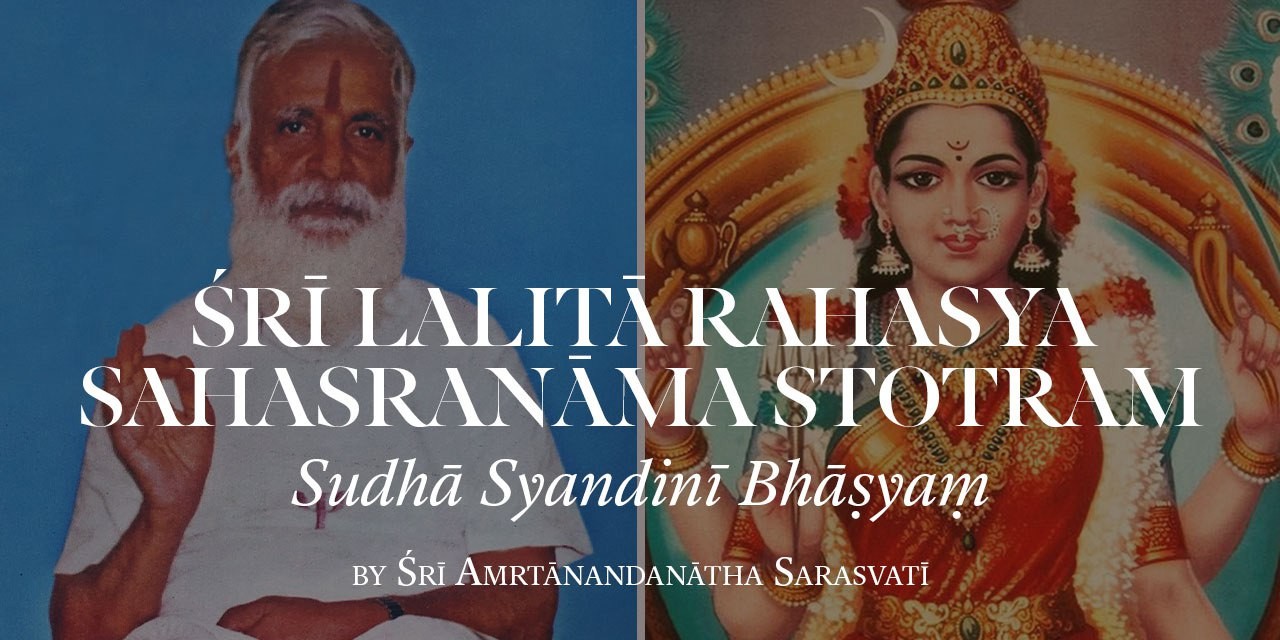
118. Bhaktipriyā
She is fond of devotion.
The words Bhakti and Śraddhā have similar meanings.
They can best be understood in the meaning of the careful attention to the details of what one was doing. It is not blind faith that is called bhakti or śraddhā. It is a faith which means a commitment born out of a deep and sincere understanding. In the Yogavāsiṣṭha, we find that Rāma as the disciple is questioning, criticizing without any inhibitions the statements made by his gurus, namely Vāsiṣṭha and Viśvāmitra. He asks many sharp inquisitive questions aimed at learning but not at deprecating the Gurus. He listens with utmost sincerity and attentiveness. Every word spoken by the Gurus carried with it the mental images associated with the pronouncements of those words by the Gurus. Rāma, in a state of absolute attention, received not only the words but also their meanings and projected mental images associated with them. This is what is called bhakti.
Bhaktis are of different kinds. Nārada, a great devotee of Viṣṇu, has written a volume on bhakti. He has written Bhakti Sūtras or “Principals of Bhakti”. He classifies bhakti essentially into two categories, gauṇa and mukhya.
Gauṇa bhakti is the devotion aimed at the divine, expecting some kind of a return for the devotion. This is mingled with such feelings as anticipation of pleasure, or fear and such.
Mukhya bhakti is the important aspect of bhakti which again is of two types called Ekānta bhakti and Ananya bhakti.
The word Ekānta means when no one else is present or interfering. It also means at the end, eka, i.e. when two listeners and the listened to only are present. This the Ekānta bhakti is characteristic of the dual state with an uninterrupted flow of communication from the God to the Devotee.
Next, the most important aspect of bhakti is Ananya bhakti, which means that devotion where there is no distinction between the transmitter and the receiver because they have become one.
When the transmission is faultless and the reception is faultless, faithfulness of transmission is complete.
When we leave the abstract levels and come down to the levels of the application of bhakti, there are many final subdivisions of the nature of bhakti, depending upon the nature of the devotion that appeals most to the devotee. It should be remembered that there can be no set rules of worship. One does what one likes to do most and what pleases one the most.
To some devotees, God in the form of father appeals most. This is especially so among all religions which propagate devotion of the male aspect of God or those cults which project the Guru as a God. Islam, Christianity, Buddhism, Jainism, Śaivism, Vaishanvism all follow these rules.
To some, the notion of love towards God appears as the most natural. Since love towards children and love towards husband or wife are all parts of love, including the tough love of punishing one's children if need be, for the benefit of the child, love can be used as an element of worship towards God.
Treating God as mother or as one's own dear wife or some of the ways that the śastra mode of worship follows.
The feeling of friendship and even the feeling of enmity are all forms appropriate to the worship of God.
The last one is called the Vaira bhakti. In the Puraṇas it is said that when the sages Sanaka, Sanadana, Sanatkumāra and Sanatsujāta were prevented admission to the divine presence of Śrīman Nārāyaṇa, on the pretext that he was in union with Lakṣmī and therefore could not be seen by the devotees, the sages gave a sapa to the two Dwarapālakas called Jaya and Vijaya. Jaya and Vijaya approached Mahāviṣṇu and asked him for relief from the anger of the sages. Then Viṣṇu told them to have a choice between hundreds of lives as devotees on the earth before they could come back to serve him again in Vaikuṇṭha or to have three lives as his enemies before they can serve him in Vaikuṇṭha. Jaya and Vijaya chose the form of worship of the God as his enemies. They were born in the Kingdom of devils as Hiraṇyākṣa, Hiraṇyakaśipu.
Since God is everyone, all forms of relationships are appropriate to God. Among these the highest form is that of Ananya bhakti. As Yājñavalkya says:
“One acquires property, children, wife, etc. for the sake of oneself. Because all these things are being acquired for oneself, then one's own self is the thing that is most dear for anyone. That self being the same as God, it is God's love, or the love of God that is reflected and showing itself as the love of material enjoyments.”
It is obvious that the Ananya bhakti, the love of God as one's own self recognizes the truth of these Upaniṣadic statements.
Some people, especially those belonging to the Kaulācara modes of worship, read this name as 'Bhākta Priyā'. Bhākta Priyā means two things:
that She is loved by Her devotees
that She loves Her devotees.
One must realise that the ultimate expression of love is merger into an identity with other. It makes no difference which name is chosen.
Source: Śrī Amṛtānandanātha Sarasvatī "Sudhā Syandinī Bhāṣyaṃ" Typed Manuscript
(an incomplete commentary on Lalitā Sahasranāma)

